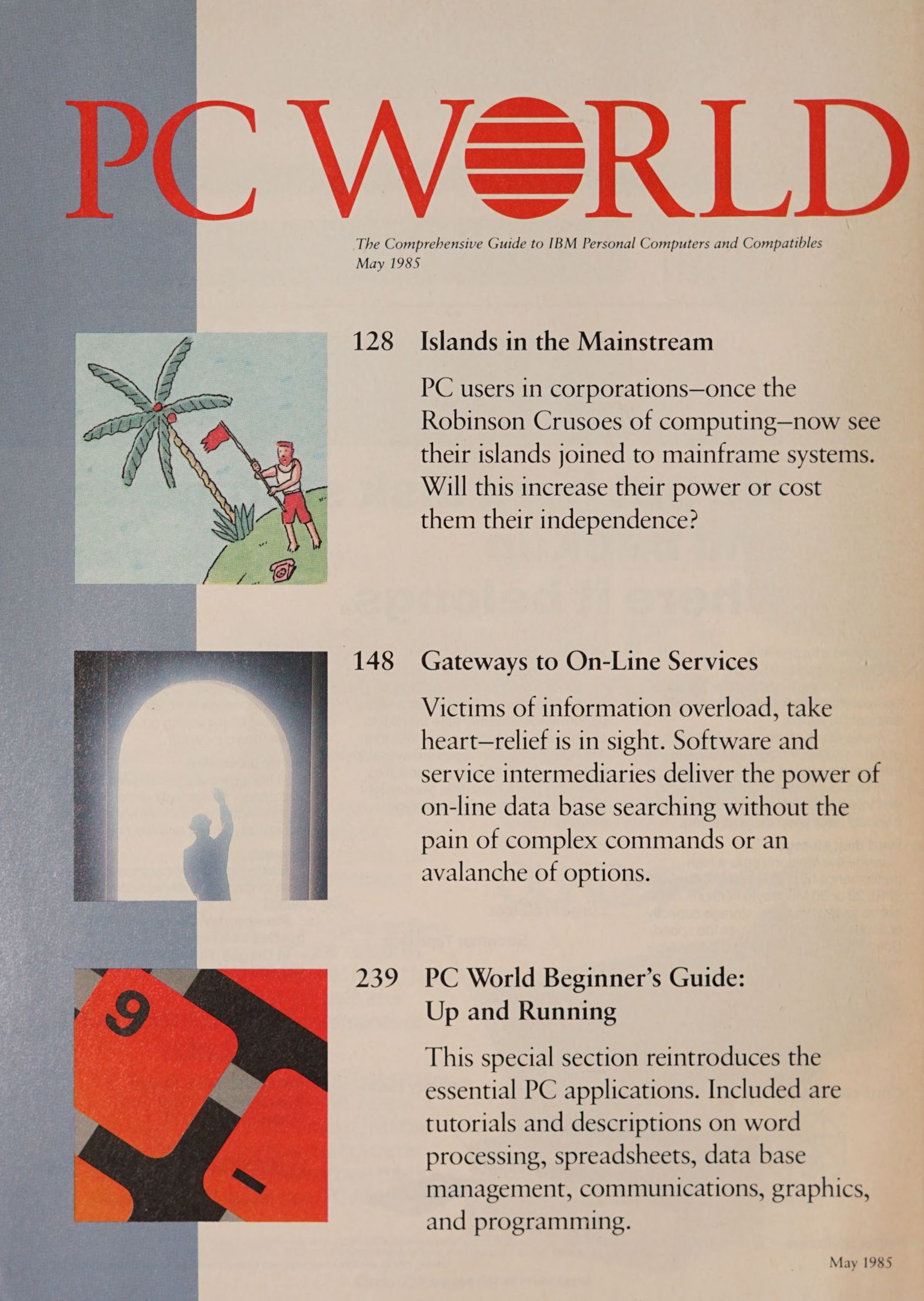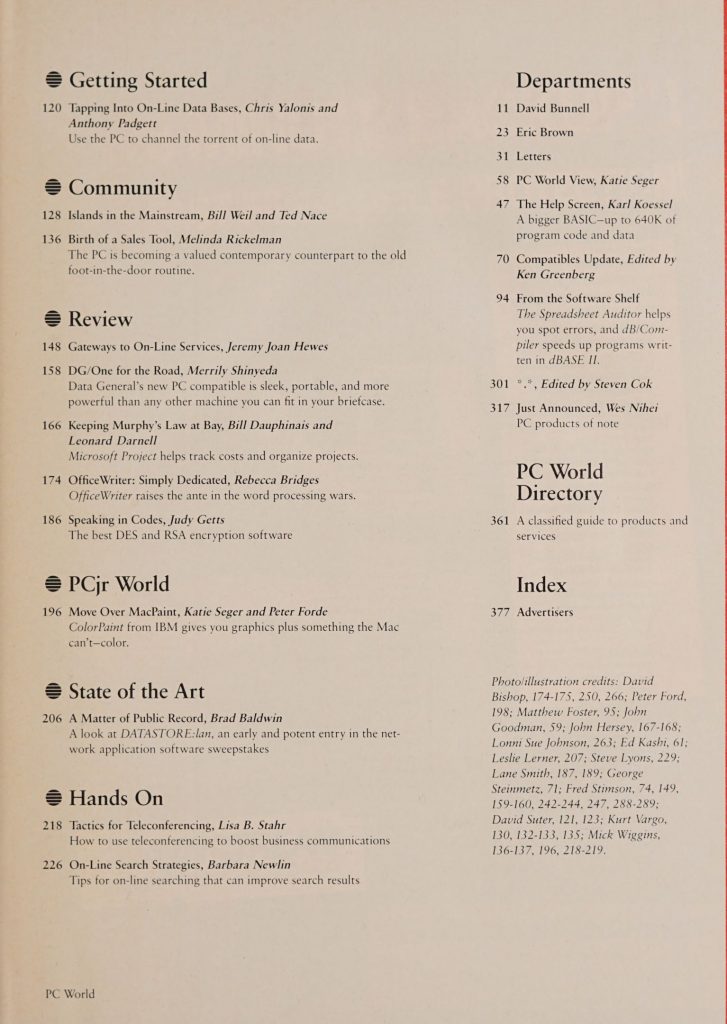Source: Computer & Video Game Magazines – PC World – May 1985
In 1985 the IBM PC was still relatively new and it (or more accurately its clones) had not yet taken over the home market. Other computers like the Commodore 64, Apple II and Atari 8-bit were cheaper, better for games, and could still do pretty much anything the PC could do. However, the PC was becoming more common in the home and had already pretty much completely taken over desktop computing in the business environment that had been dominated by custom systems and CP/M based systems only a few years earlier (for businesses that even had computers anyway). PC World was one of the most popular PC magazines and the May 1985 issue checks in at over 400 pages. It’s hard to even conceive of a magazine having that many pages today. It includes:
Getting Started
- Tapping Into On-Line Data Bases – While the public Internet was still years away, there were various online services that could be accessed with a modem and a fee (usually per minute). There were various online databases that could be accessed and for a variety of use cases, this could replace doing research at a library.
Community
- Islands in the Mainstream – This article discusses the implications of connecting PCs to mainframes, something that was starting to happen in the business world.
- Birth of a Sales Tool – Automating sales forecasting with Framework and Lotus 1-2-3.

Table of Contents from the May 1985 of PC World
Review
- Gateways to On-Line Services – While online databases could be useful, they were usually cryptic. This article discusses gateway services that would translate English language like search commands into something these databases could understand. If only they’d had Google…
- DG/One for the Road – Review of the Data General/one, a laptop featuring a 12-inch LCD screen (the same size as typical PC monitors at the time), a 3.5″ 720K double desnsity disk drive (with a second drive optional), an optional external 5.25″ disk drive (for $895), an 80C88 CPU, 128K RAM (upgradeable to 512K), an optional 300bps internal modem ($300) or 1200bps modem ($699), and an OPTIONAL rechargeable battery for $178. The base price for 1 disk drive, 128KB, no modem etc. was $2895. Upgraded to be a reasonably usable system for business purposes it would have cost you $4571.
- Keeping Murphy’s Law at Bay – A review of Microsoft Project project planning software.
- OfficeWriter: Simply Dedicated – A review of this word processing software from Office Solutions.
- Speaking in Codes – A look at two software packages that can be used to encrypt your files: DataSafe and Crypt Master. DataSafe uses DES while Crypt Master uses RSA encryption. On a typical PC of the time, Crypt Master could perform encryption at 1.25K per minute and decryption at 131 bytes per minute. Given the shorter key lengths probably used, you could probably crack that encryption with brute force on today’s systems much faster…
PCjr World
- Move Over MacPaint – A look at PCjr ColorPaint, the PCjr’s answer to MacPaint.
State of the Art
- A Matter of Public Record – A look at DATASTORE:lan, sfotware for managing a local area network.
Hands On
- Tactics for Teleconferencing – Teleconferencing today probaly brings to mind something like Zoom or Microsoft Teams. In 1985 it meant e-mail and voice calls.
- On-Line Search Strategies – Some hints on how to approach searching for information on-line. This wasn’t like Google. Different online services contained different databases that could be searched in different ways. For example, if you want to search for information about U.S. sales of personal computers, you could enter “S PC = 3573098(L)EC = 64(L)CC=1USA” into the appropriate online database. Intuitive it was not and search results could be just as cryptic.
Departments
- David Bunnell – Dave Bunnell discusses software piracy and copy protection.
- Eric Brown – Eric Brown looks at online databases, most of which consists of bibliographic abstracts from journals around the world.
- Letters – Letters from readers about DisplayWrite 2, the first word processor, the current state of the personal computer market, and more.
- PC World View – The president of the Boston Computer Society (Jonathan Rotenberg) looks at the history and the future of personal computing.
- The Help Screen – Questions answered about accessing more than 64K in BASIC, programming the TRS-80 Model III, and more.
- Compatibles Update – The current state of the PC Clone market plus an expansion board for CP/M based machines that turn them into a PC compatible (the SWP Co-Power-88) which includes an on board 8088 CPU, 128K or 256K of RAM, DOS 2.11 and more for $400-$500 depending on options.
- From the Software Shelf – A brief look at recent software releases including Heads of the Coin (an interactive fiction game), PC Write (word processor), PC-File III version 2 (data manager), The Spreadsheet Auditor (checks spreadsheet formulas for errors), and more.
- Just Announced – A look at new products including the Ericsson 8088 based PC, the Kaypro 16 “transportable” computer, the UltraLink 1200bps modem, the Epson JX-80 color dot matrix printer, and more.
…and much more!





